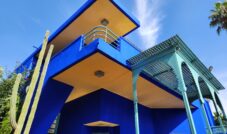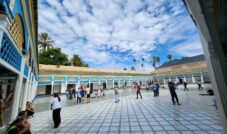Need an escape from the concrete jungle? Step into another type of jungle at the Barbican Conservatory
Verdict: The Barbican Conservatory offers a free alternative to Kew Gardens. Granted, it’s a lot smaller, but it’s still very much worth a visit. And it’s closer to central London than Kew Gardens. with more things to do before or afterwards nearby.
Directions to Barbican Conservatory
Address: Level 3, Barbican Centre, Silk St, London EC2Y 8DS
Closest tube station: Moorgate or Barbican
Admission is free.
Tickets for the Conservatory are released one month in advance online. A limited number of day tickets are released for online booking from 9:30am each day that the Conservatory is open.
Ticket holders can gain entry any time during their slot. Stay as long as you like
Check ticket availability here
What to do before/after visiting Barbican Conservatory?
- The Barbican Centre (of course). See an art exhibition, go to the theatre, the watch a movie at the cinema or have a bit to eat. This is why I love The Barbican Centre, there’s so much choice
- Visit the hidden gem that is Guildhall and the roman Amphitheatre in the basement – 10 minute walk
- Throw some darts at Flight Club Shoreditch – 11 minute walk
- Go inside the incredibly beautiful St. Paul’s Cathedral – 14 minute walk
- Have some delicious food with an incredible panoramic view of East London at Duck & Waffle – 16 minute walk
- Wander around and browse the stalls at Spitalfields Market or eat at the food market (in my opinion one of the best in London) – 21 minute walk
Barbican Conservatory review and photos
I could happily spend a day in The Barbican Centre.
This performing arts centre is one the largest in Europe; you won’t be short of things to do here.
The Barbican’s art programme is one of the best in London. I love the Curve for example, which challenges artists like the United Visual Artists to create an exhibition that fills the space of a curve. And I thought their Pop Art Design exhibition in the main hall presented the perfect introduction to the era.
There’s also the theatre and cinema too. The theatre hall is a lot more comfortable than the old, cramped West End theatres. I enjoyed a modern adaptation of Macbeth with Christopher Eccleston.
Not long ago I discovered a new reason to love visiting the Barbican.
Hard to believe London’s second largest conservatory (after Kew Gardens), is in The City. That gives you an idea how large the Barbican actually is.
Visiting Barbican Conservatory is prefect for rainy days in London. See the latest opening times.
How did they get the plants and trees into the conservatory? Via a crane on the road.











P.S you might be interested in these related articles about London…
Tips On How To Save Money On Food, Theatre & Tickets In London
Towards the back of the Barbican centre is a lovely place to sit outside too (when the sky isn’t grey).

It’s also worth walking around the estate too.


You might be interested in…
Barbican Conservatory history and architecture
Construction and Inception
The Barbican Conservatory is not merely a garden but a harmonious blend of architecture and horticulture. Its story begins with the construction of the Barbican Centre itself, a groundbreaking project initiated in the 1960s. The vision was to create a multifaceted cultural hub that would include residential spaces, performing arts venues, and communal areas.
As part of this grand design, the Barbican Conservatory was conceived as an integral component, conceived to provide residents and visitors with a lush retreat in the heart of the bustling city. The conservatory, designed by architects Chamberlin, Powell, and Bon, was added to the complex and officially opened its doors in 1984.
Design and Architecture
The architects envisioned a space that seamlessly integrated with the brutalist architecture of the Barbican Centre while offering a stark contrast in terms of atmosphere. The result is a striking combination of concrete structures and the vibrant, organic beauty of the conservatory. The architecture itself is a marvel, featuring a high glass roof that floods the space with natural light, creating an environment conducive to the flourishing of diverse plant species.
The design principles reflect a careful consideration of environmental conditions, providing optimal light and temperature for the diverse flora housed within. The Conservatory spans over 23,000 square feet, making it one of the largest conservatories in London, a true urban oasis where visitors can escape the urban hustle and immerse themselves in a botanical haven.
Barbican Conservatory FAQs
1. What is the Barbican Conservatory?
The Barbican Conservatory is a botanical oasis situated within the Barbican Centre in London. It features a diverse collection of plant species housed under a striking glass roof, providing a unique blend of nature and architecture.
2. When was the Barbican Conservatory built?
The Barbican Conservatory was added to the Barbican Centre and officially opened in 1984 as part of the larger architectural project initiated in the 1960s.
3. How large is the Barbican Conservatory?
The Conservatory spans over 23,000 square feet, making it one of the largest conservatories in London.
4. What types of plants can be found in the Barbican Conservatory?
The Conservatory boasts a diverse collection of plant life, including tropical palms, ferns, arid desert plants, succulents, cacti, and various flowering plants. The intentional variety creates microclimates representing different ecosystems.
5. Can I visit the Barbican Conservatory?
Yes, the Barbican Conservatory is open to the public. However, it’s advisable to check the Barbican Centre’s official website for any updates on opening hours and potential closures for private events.
6. Are there guided tours available?
Yes, the Barbican Conservatory offers guided tours. These tours provide insights into the diverse plant life, the history of the Conservatory, and its role within the Barbican Centre. It’s recommended to check the Barbican Centre’s website for tour schedules.
7. Is there an admission fee to enter the Barbican Conservatory?
Entrance to the Barbican Conservatory is free. However, it’s essential to note that the Conservatory may be closed during private events, so checking the official website for the latest information is advisable.
8. Can I host events or weddings at the Barbican Conservatory?
Yes, the Barbican Conservatory is a versatile venue and can be hired for private events, weddings, and other functions. Interested parties can contact the Barbican Events team for more information and availability.
9. Is photography allowed inside the Barbican Conservatory?
Yes, photography is generally allowed for personal use. However, it’s recommended to be mindful of other visitors, especially during tours or events. For commercial or professional photography, it’s advisable to contact the Barbican Centre for permission.











